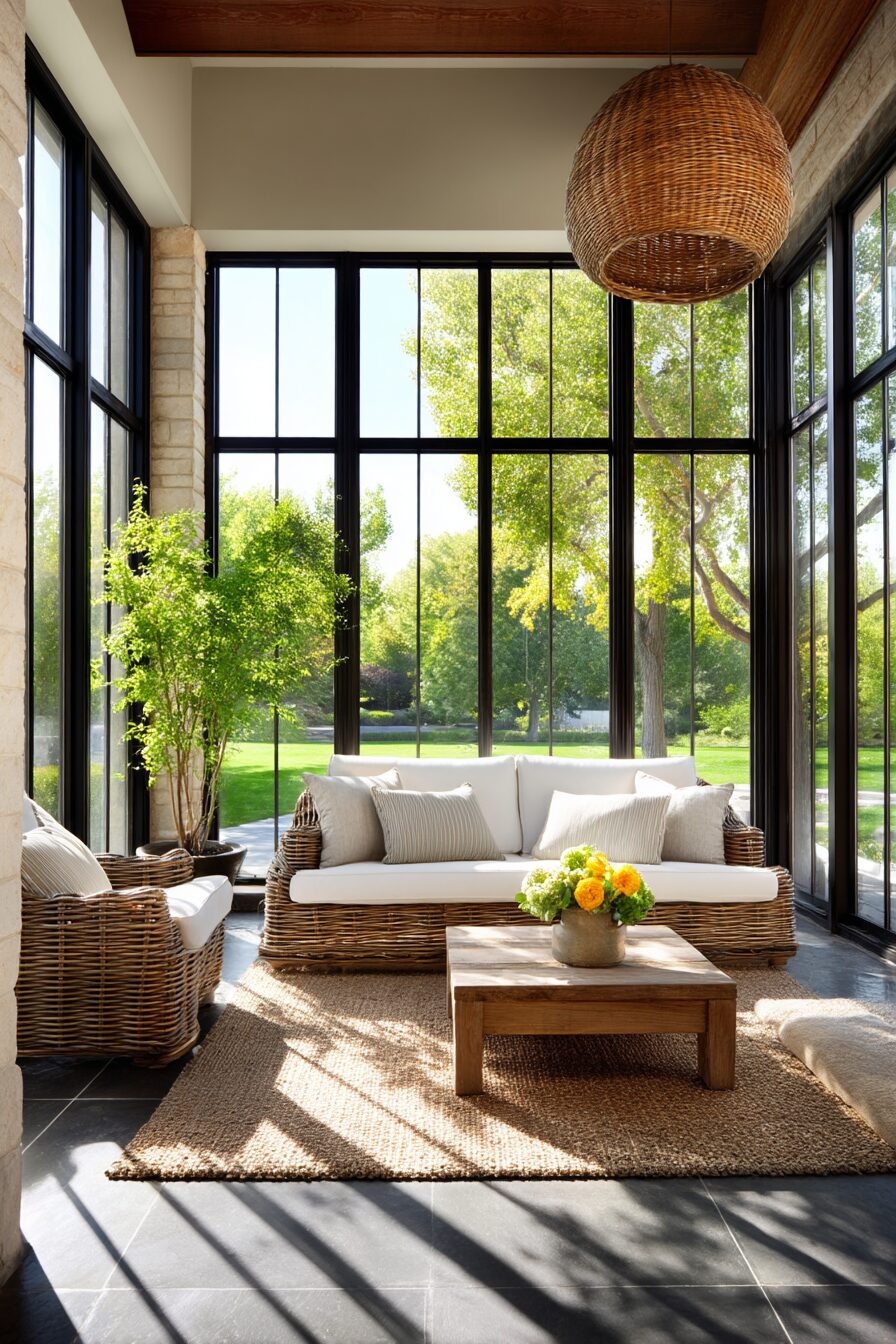Sunrooms have evolved from simple glass enclosures to sophisticated living spaces that blend the comforts of indoor living with the beauty of the outdoors.
These light-filled sanctuaries offer a perfect retreat regardless of weather, allowing you to enjoy nature’s beauty year-round while staying protected from the elements.
Modern sunroom designs combine innovative architecture, thoughtful materials, and strategic layouts to create spaces that not only brighten your home but also enhance your lifestyle.
✨Click to Get My 101 FREE Designer Room Ideas
Minimalist Glass Sanctuaries
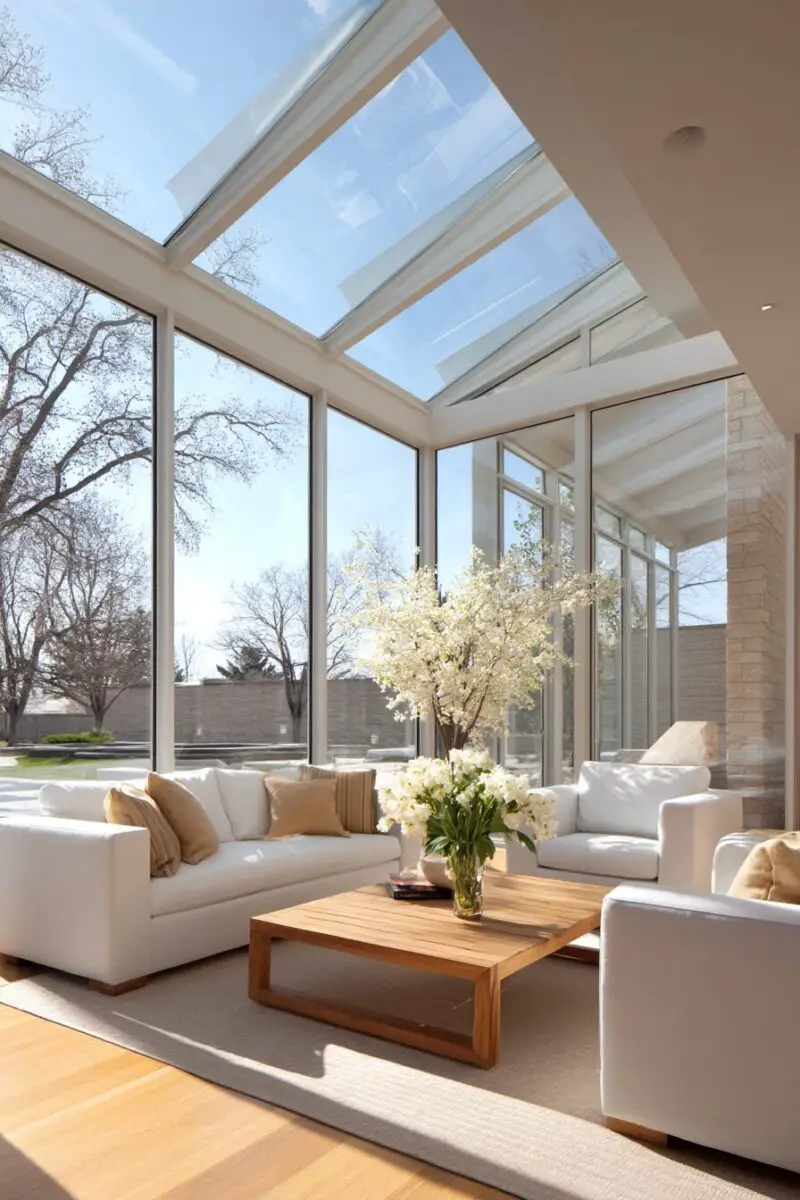
The pinnacle of modern sunroom design embraces clean lines and unobstructed views through floor-to-ceiling glass panels.
These transparent walls create the illusion of sitting directly in your garden or landscape without barriers.
Minimal aluminum or steel framing in black or dark bronze provides structural support while maintaining a sleek, contemporary aesthetic.
The beauty of this design lies in its simplicity – natural light becomes the main design element, creating ever-changing patterns as the sun moves throughout the day.
Neutral color palettes of whites, grays, and natural wood tones allow the outdoors to remain the focal point without competition.
Furniture selections should mirror this restraint with low-profile seating in simple forms that won’t obstruct sightlines to the exterior.
Polished concrete or large-format tile flooring continues the minimalist theme while providing practical durability against the increased sunlight exposure.
Automated blinds or shades in sheer fabrics can be incorporated discreetly into the ceiling to manage light levels without compromising the clean design.
Temperature control becomes essential in these glass-enclosed spaces, so consider investing in high-performance glazing with UV protection and energy-efficient heating and cooling systems.
Strategically placed skylights can further enhance the open, airy feeling while improving ventilation during warmer months.
Night lighting should be subtle and architectural – think recessed ceiling fixtures or minimal track lighting that won’t create reflections on the glass when darkness falls.
The acoustics in glass-heavy spaces require attention too – consider incorporating sound-absorbing elements like area rugs or acoustic ceiling treatments to prevent echo.
Modern minimalist sunrooms work particularly well with contemporary or mid-century home styles but can be adapted to complement traditional architecture through thoughtful transitions.
Biophilic Jungle Retreats
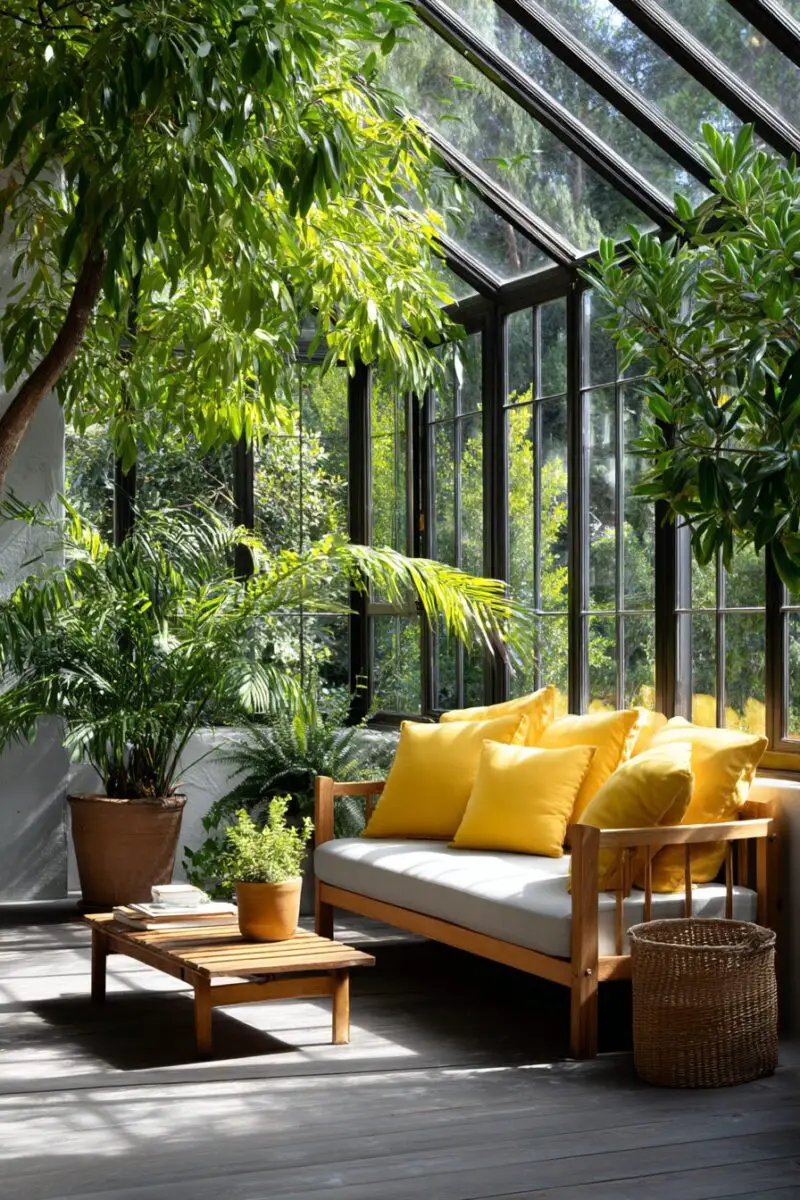

Transform your sunroom into a lush indoor garden that satisfies the innate human desire to connect with nature.
These plant-focused spaces blur the line between conservatory and living area, creating oxygen-rich environments that improve air quality while delighting the senses.
The key to successful biophilic sunroom design lies in layering plants of varying heights, textures, and leaf shapes to create a natural ecosystem feel.
Start with structural plants like fiddle leaf figs, bird of paradise, or indoor palms that can serve as living architecture within the space.
Fill in with medium-sized plants on stands or shelving to create visual interest at different eye levels throughout the room.
Complete the jungle effect with trailing varieties like pothos, philodendron, or string of pearls cascading from ceiling-mounted planters or high shelves.
Proper humidity management becomes crucial in plant-heavy environments, so consider incorporating a small water feature or dedicated humidifier.
Furniture should be moisture-resistant yet comfortable – think weather-treated woods, rattan, or powder-coated metals with washable fabric cushions.
Color palettes draw from nature itself – rich greens complemented by earthy neutrals, with occasional pops of color from flowering plants or vibrant foliage.
Flooring options should balance practicality with aesthetic appeal – natural stone, sealed concrete, or composite decking materials stand up well to occasional water spillage.
Lighting requires special consideration for both human and plant inhabitants – full-spectrum grow lights can supplement natural sunlight during darker months.
Temperature fluctuations must be managed carefully, as most houseplants prefer consistent conditions without drafts or extreme heat.
Create designated pathways through your indoor jungle to evoke the feeling of a tropical garden exploration, even in limited square footage.
Indoor-Outdoor Fusion Spaces
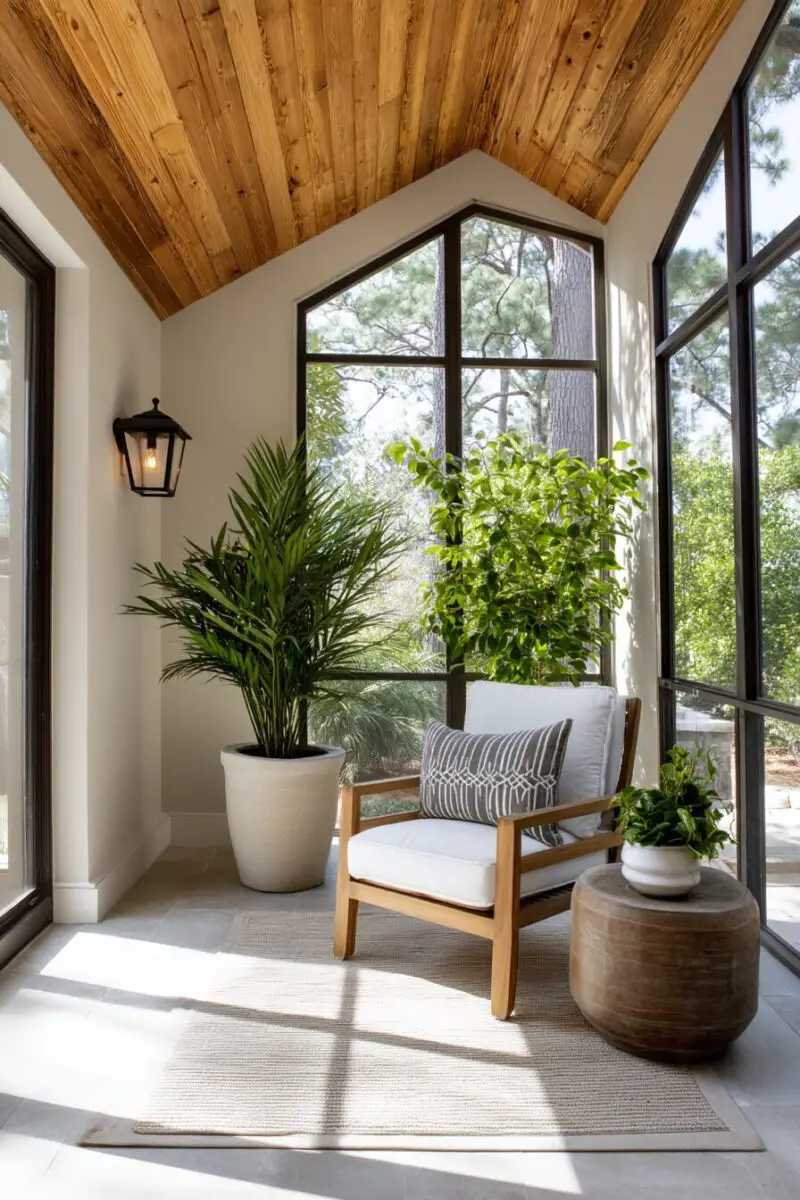

Modern sunroom design reaches its pinnacle when the boundary between inside and outside virtually disappears.
These revolutionary spaces utilize retractable glass walls or folding door systems that open completely to blend your sunroom with adjacent patios or gardens.
The true magic happens when you maintain consistent flooring materials from inside to out, creating a seamless visual flow that tricks the eye into seeing one unified space.
Furniture arrangements should be planned for flexibility, allowing pieces to function well whether the walls are open or closed.
Weather-resistant performance fabrics have revolutionized these hybrid spaces, offering indoor comfort with outdoor durability for upholstered pieces.
Ceiling design becomes a critical element – extended roof overhangs or pergola structures can provide shade and weather protection while maintaining the open-air feeling.
Thoughtful landscaping directly outside these fusion spaces completes the integrated design, with plantings that complement interior elements.
Heating and cooling solutions require careful planning, often incorporating radiant floor heating, ceiling fans, and discrete outdoor heaters to extend usability.
Smart home technology can elevate the experience further, with automated systems that can close glass walls and adjust climate settings when weather changes suddenly.
Lighting design should work harmoniously across both zones, with weather-resistant fixtures that create consistent ambiance from inside to out.
For regions with insect challenges, retractable screens can be incorporated into door systems, preserving the open-air experience without unwanted visitors.
These fusion spaces excel at entertaining, allowing you to host gatherings that flow effortlessly between indoor comfort and outdoor freshness.
Contemporary Bohemian Sunspaces


Inject personality and eclectic charm into your light-filled retreat with the contemporary bohemian approach to sunroom design.
This style balances modern architectural elements with globally-inspired textiles, handcrafted details, and an intentionally collected look.
Begin with a clean structural envelope – modern window systems and simple architecture provide the perfect blank canvas for bohemian layers.
Woven pendants or rattan light fixtures create dancing patterns of light and shadow that evolve throughout the day.
Seating should prioritize comfort and conversation, with deep cushions, floor pillows, and perhaps a suspended hanging chair as a whimsical focal point.
Textiles become the heart of bohemian sunrooms – layer vintage rugs, handwoven throws, and pillows in complementary patterns that feel curated rather than matched.
Plants are non-negotiable in these spaces, with macramé hangers, ceramic pots, and woven baskets adding textural interest to your greenery display.
Color palettes can range from sun-washed neutrals to vibrant jewel tones, depending on your preference, but always include variations in texture.
Furniture mixing is encouraged – pair a sleek modern sofa with handcrafted side tables, vintage rattan pieces, or repurposed items for authentic character.
Window treatments should maintain the light-filled quality of the space – consider natural woven shades that filter light beautifully or sheer curtains that billow gently.
Incorporate meaningful objects collected from travels or artisanal sources as decor elements that tell your personal story.
Wall treatments can enhance the bohemian vibe – consider a feature wall with textured plaster, a botanical wallpaper, or a gallery collection of artwork.
The magic of contemporary bohemian spaces comes from balancing casualness with intention – every element should feel both comfortable and thoughtfully selected.
✨Click to Get My 101 FREE Designer Room Ideas
Scandinavian-Inspired Light Havens
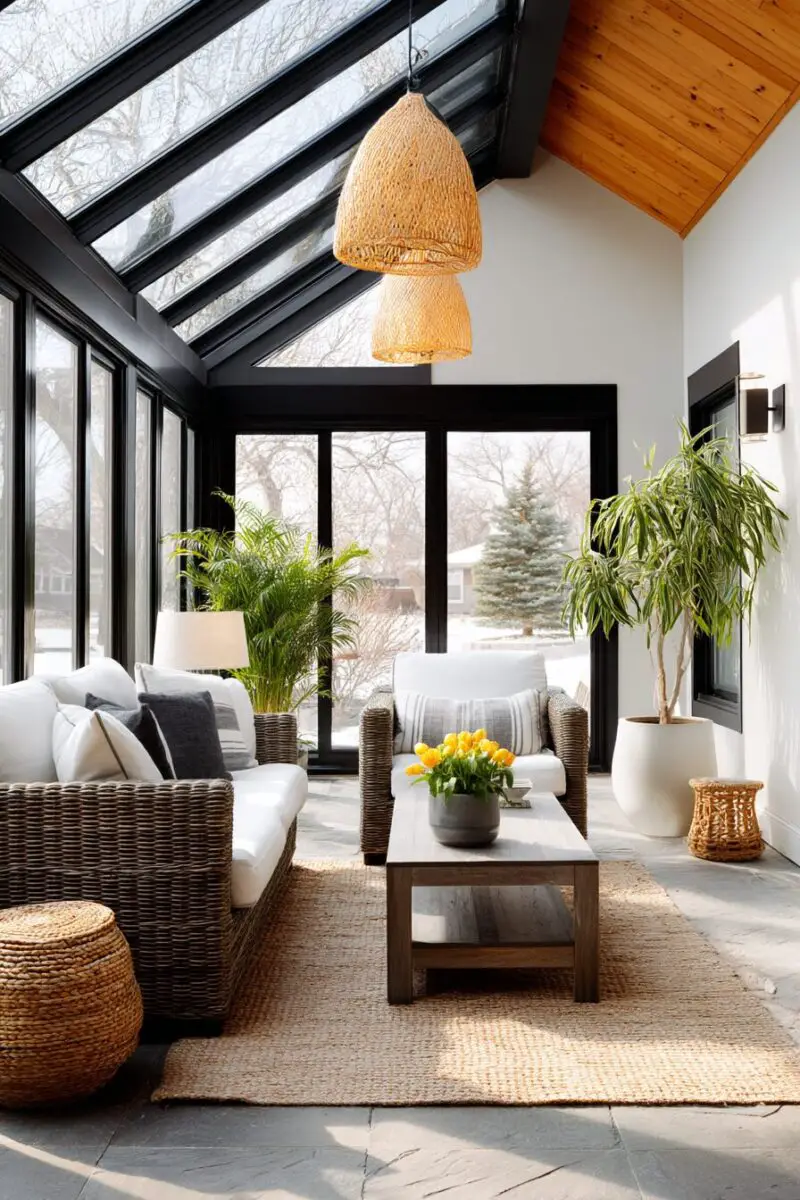
Embrace the Nordic approach to sunroom design with spaces that maximize light reflection while creating a cozy retreat for all seasons.
Scandinavian sunrooms begin with a bright white base palette for walls and ceilings to amplify natural light, even during shorter winter days.
Light-toned wood elements – think ash, birch, or bleached oak – add warmth without heaviness to floors, furniture, and architectural details.
The furniture philosophy follows the “hygge” concept – comfortable, functional pieces that invite relaxation without unnecessary ornamentation.
Clean-lined seating with simple forms predominates, often in neutral fabrics with thoughtfully placed throws and cushions for added comfort.
Natural materials take center stage throughout the space – wool, linen, leather, and unfinished woods create a tactile experience that connects to the outdoor environment.
Storage solutions should be integrated and minimal, maintaining the uncluttered aesthetic that characterizes Scandinavian design.
Contrast becomes important in these light-filled environments – incorporate black metal elements in lighting fixtures or window frames to anchor the brightspace.
Textiles add essential texture and warmth – sheepskin throws draped over chairs, wool area rugs, and linen curtains soften the minimalist architectural elements.
Plants feature prominently but selectively – choose architectural varieties like rubber plants or fiddle leaf figs in simple white or terracotta pots.
Lighting requires special attention for year-round enjoyment – incorporate multiple sources including floor lamps, table lamps, and candles for evening ambiance.
Functional accessories like oversized floor cushions, ceramic mugs for tea, and woven baskets enhance the practical comfort of the space.
The beauty of Scandinavian sunrooms lies in their adaptability – they transition seamlessly from bright summer reading rooms to cozy winter retreats with minimal adjustments.
Multi-Functional Sunroom Offices
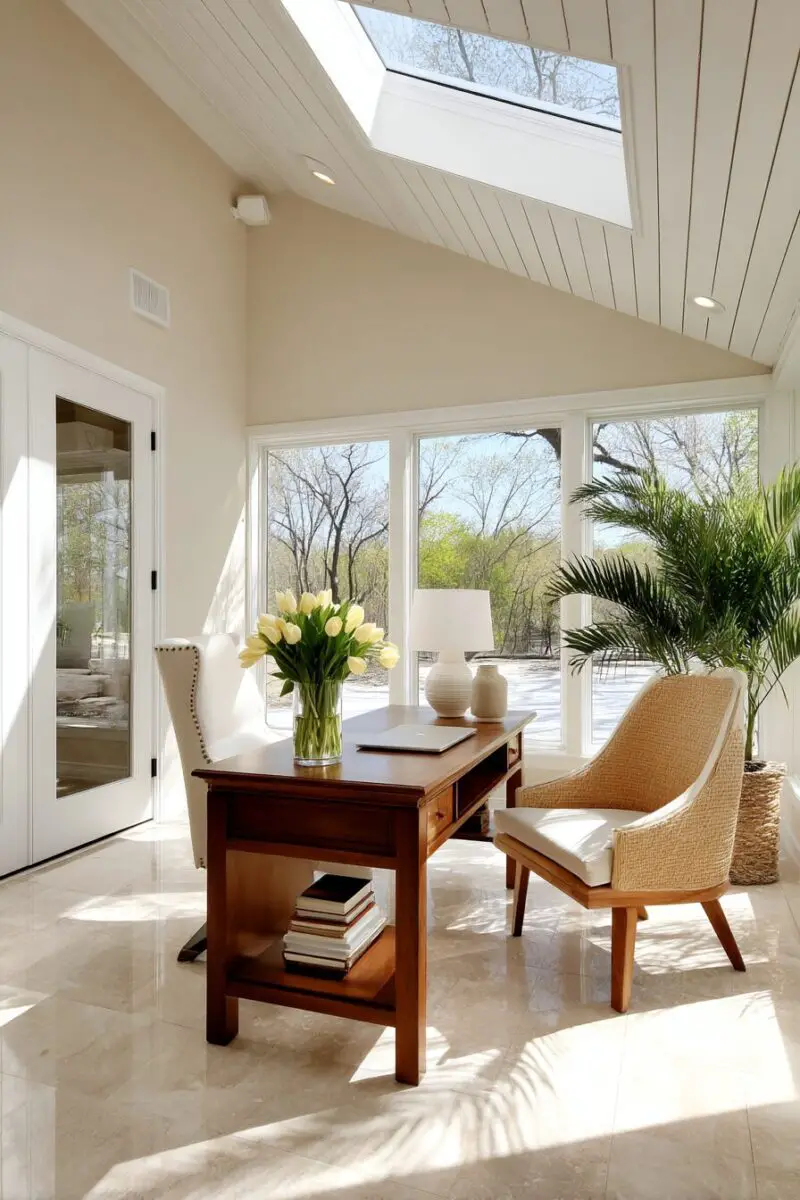
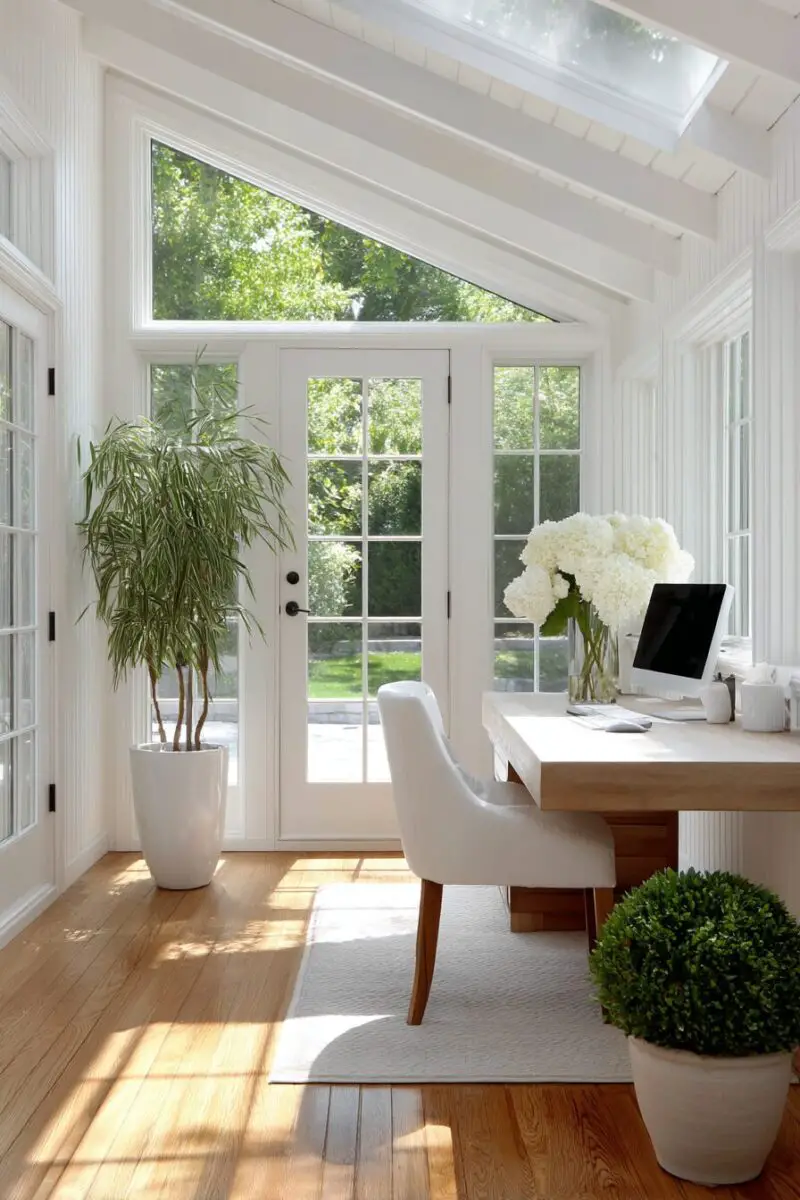
The pandemic-accelerated work-from-home movement has elevated sunrooms into ideal multi-purpose spaces that combine productivity with natural inspiration.
These light-filled work environments harness the proven benefits of natural daylight on focus, creativity, and overall mental wellbeing.
The foundation of an effective sunroom office begins with thoughtful zoning – clearly defined areas for work, relaxation, and transition activities.
Positioning your desk to face the outdoors rather than having windows behind your computer screen prevents distracting glare while maximizing inspirational views.
Invest in proper window treatments like adjustable blinds or shades that can control light levels throughout the day as the sun’s position changes.
Furniture selections should prioritize ergonomics alongside aesthetics – an adjustable chair and proper desk height remain essential even in beautiful surroundings.
Technology integration requires thoughtful planning – concealed charging stations, wireless capabilities, and sufficient outlets preserve the room’s tranquility.
Cable management becomes particularly important in glass-surrounded spaces where hiding wires behind walls isn’t always possible.
Acoustics deserve special attention in sunrooms, where hard surfaces can create echo problems during video calls or virtual meetings.
Incorporate sound-absorbing elements like area rugs, upholstered furniture, or even decorative acoustic panels disguised as artwork.
Plant life serves double duty in these spaces – enhancing air quality during long work sessions while creating natural privacy screening from neighbors.
Color psychology can guide your design choices – blues and greens promote focus and reduce eye strain, while warmer accents energize creative thinking.
Luxury Resort-Style Sunrooms
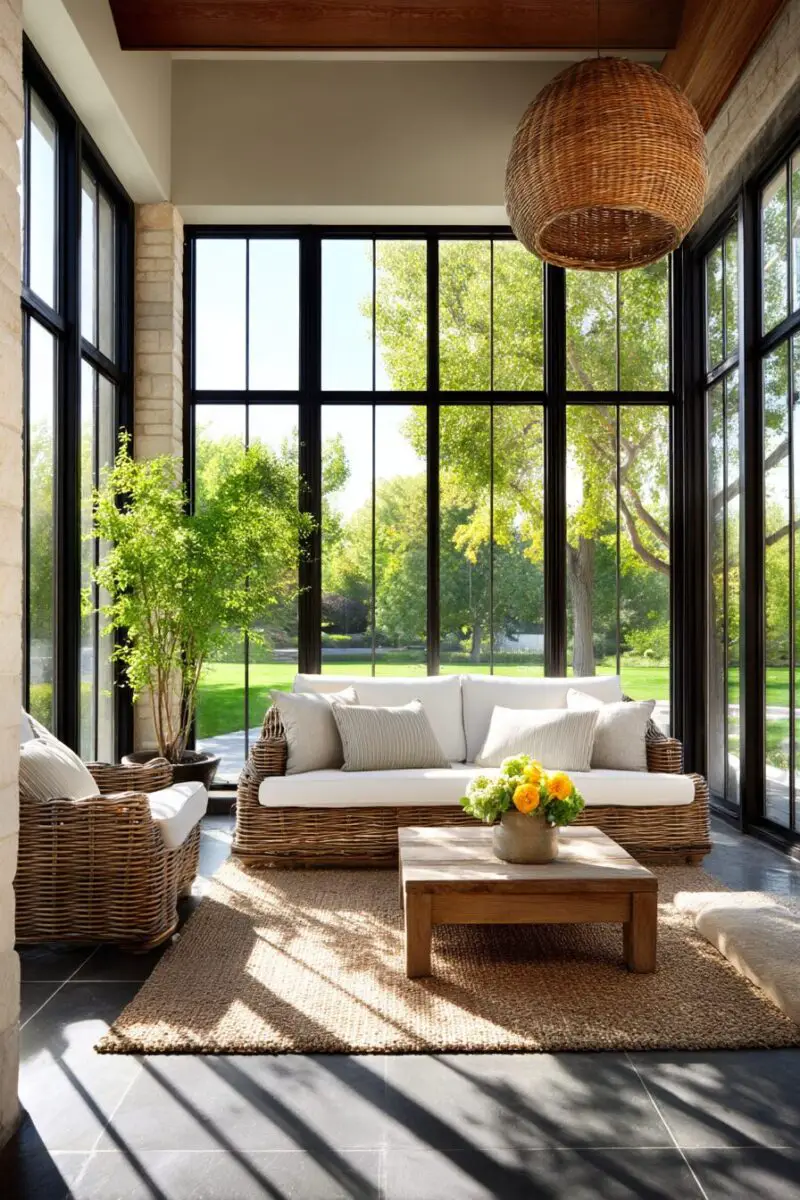
Transport yourself to a five-star destination without leaving home by creating a sunroom that captures the essence of luxury resort living.
These indulgent spaces prioritize comfort and relaxation with high-end materials, thoughtful amenities, and attention to sensory experiences.
Start with oversized, deeply cushioned seating that invites hours of lounging – think custom sectionals or chaise lounges worthy of a poolside cabana.
Incorporate a small wet bar or beverage station with a compact refrigerator and glassware storage for convenient refreshment access.
Material selections should skew toward the sumptuous – natural stone surfaces, exotic woods, and performance fabrics that mimic the luxury of silk or velvet.
Water features add both visual interest and soothing ambient sound – consider a small wall fountain, bubble wall, or even a compact hot tub if space allows.
Lighting must be carefully layered for different moods and times of day – include statement fixtures that serve as artistic focal points alongside practical task lighting.
Temperature and climate control reach sophisticated levels in these spaces – think heated floors for cooler months and discrete misting systems for summer comfort.
Audio systems integrated invisibly into the architecture allow for immersive soundscapes that complete the sensory resort experience.
Privacy considerations become paramount in creating a retreat-like atmosphere – motorized screens, strategic landscaping, or switchable privacy glass protect your sanctuary.
Decorative elements should be curated rather than abundant – a few striking art pieces or sculptural plants make stronger statements than numerous small accessories.
Color palettes often draw from luxury destinations – crisp coastal whites and blues, tropical jewel tones, or serene spa-like neutrals set the desired mood.
The ultimate luxury sunroom includes thoughtful details that anticipate needs – integrated charging stations, easily accessible throws for temperature changes, and surfaces to accommodate refreshments.
Industrial-Modern Glass Houses
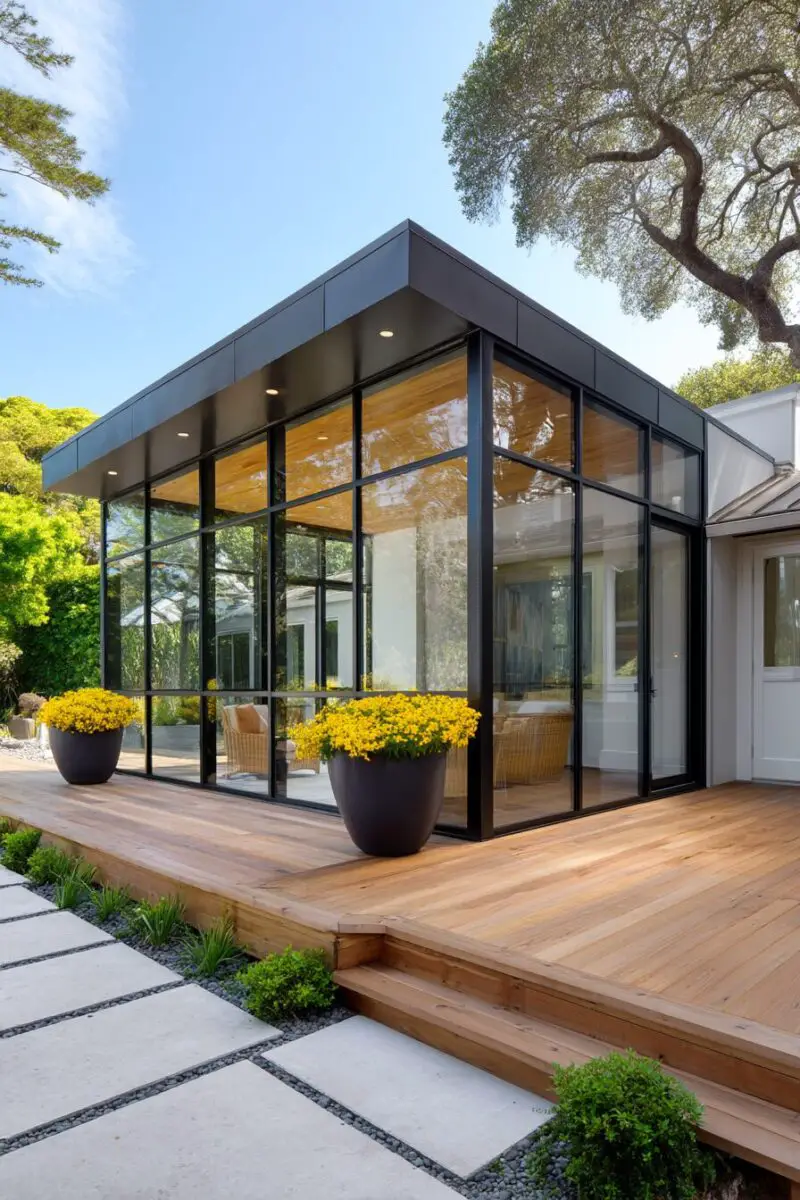

Embrace architectural contrast by combining raw industrial elements with refined glass expanses in a sunroom that celebrates structural honesty.
These distinctive spaces feature exposed structural components like steel beams, trusses, or concrete elements as deliberate design statements rather than elements to conceal.
Black-framed windows and doors in aluminum or steel create dramatic graphic lines against the transparency of glass walls and ceilings.
Polished concrete flooring offers practical durability while reinforcing the industrial aesthetic and providing thermal mass to regulate temperature fluctuations.
Furnishings should balance the architectural boldness – consider streamlined pieces with industrial-inspired details like visible joinery or metal accents.
Color palettes typically remain restricted to neutrals with materials providing the visual interest – think charcoals, blacks, warm woods, and metal finishes.
Lighting fixtures become sculptural elements themselves – exposed bulb pendants, articulating wall sconces, or vintage-inspired factory lights complement the aesthetic.
Incorporate reclaimed materials selectively – perhaps a feature wall of weathered wood or repurposed factory furniture that tells a story.
Plants add essential softness to these structured spaces – architectural varieties like succulents, snake plants, or large-leafed tropicals complement rather than compete with the design.
Temperature management requires careful planning in these glass-heavy spaces – consider ceiling fans with industrial styling and high-performance glazing for comfort.
Storage solutions should continue the honest material approach – open shelving in raw steel or reclaimed wood displays collections without visual clutter.
Scale becomes particularly important in industrial designs – oversized art pieces, substantial furniture, and bold lighting prevent the space from feeling cold or impersonal.
The beauty of industrial-modern sunrooms lies in their celebration of contrasts – the weightlessness of glass against the solidity of steel, the warmth of wood against cool concrete.
✨Click to Get My 101 FREE Designer Room Ideas
Curved Organic Architecture Sunrooms

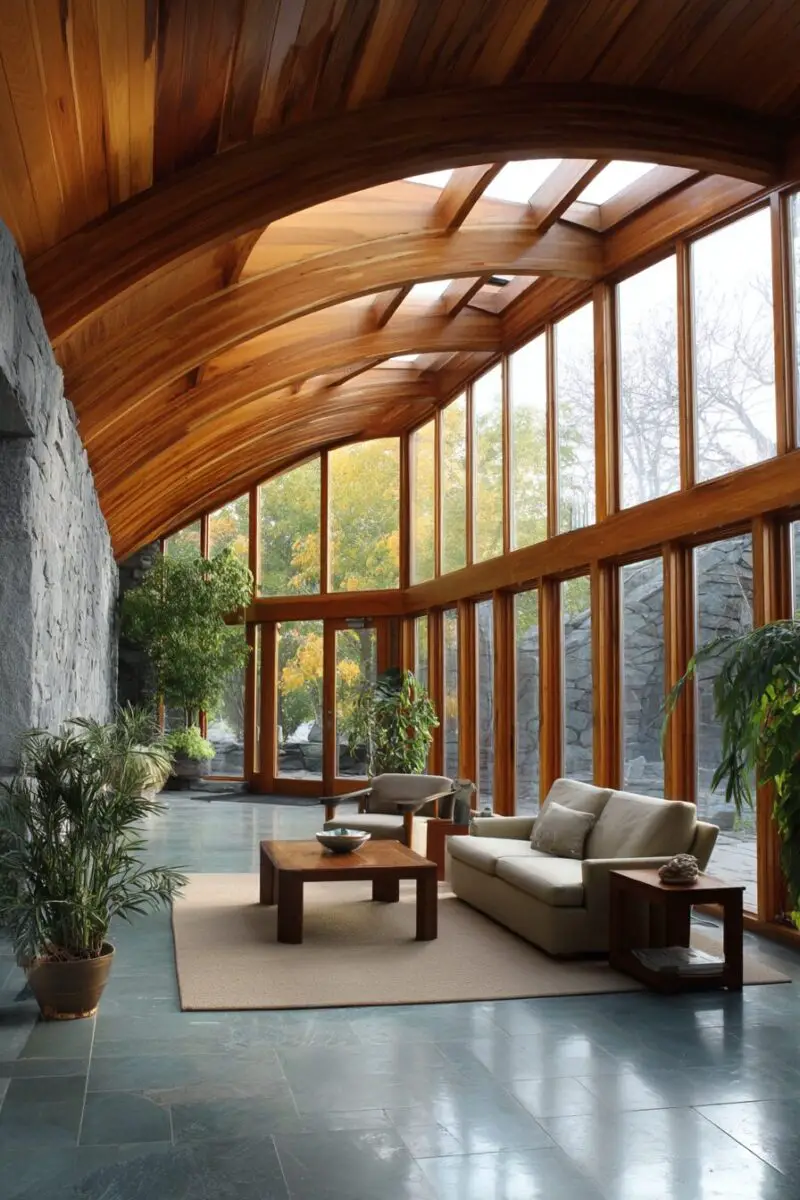
Break away from traditional rectilinear designs with sunrooms that embrace flowing curves, organic forms, and biomorphic architecture.
These sculptural spaces reject the typical box-like glass enclosures in favor of undulating walls, dome-like ceilings, and free-form layouts that mimic natural formations.
Advanced glass manufacturing and engineering techniques now make curved and bent glass more accessible, allowing for dramatic arched windows, bubble skylights, and cylindrical glass walls.
The resulting spaces feel almost otherworldly – like inhabiting the interior of a soap bubble or a natural cave formation bathed in sunlight.
Structural support becomes an artistic expression rather than something to minimize, with curved laminated wood beams, organically-shaped steel members, or 3D-printed components creating visual interest.
Furniture selection requires special consideration – custom built-in seating that follows the curved walls creates cohesion, while centrally placed modular pieces can adapt to non-rectangular floor plans.
Flooring patterns can enhance the organic feeling – think spiral tile arrangements, curved wood plank installations, or poured resin floors with swirling patterns that complement the architecture.
Lighting design becomes particularly important in these uniquely shaped spaces – recessed fixtures following curved ceiling lines or organically shaped pendants that echo the architectural forms maintain design consistency.
Sustainable Eco-Sunrooms
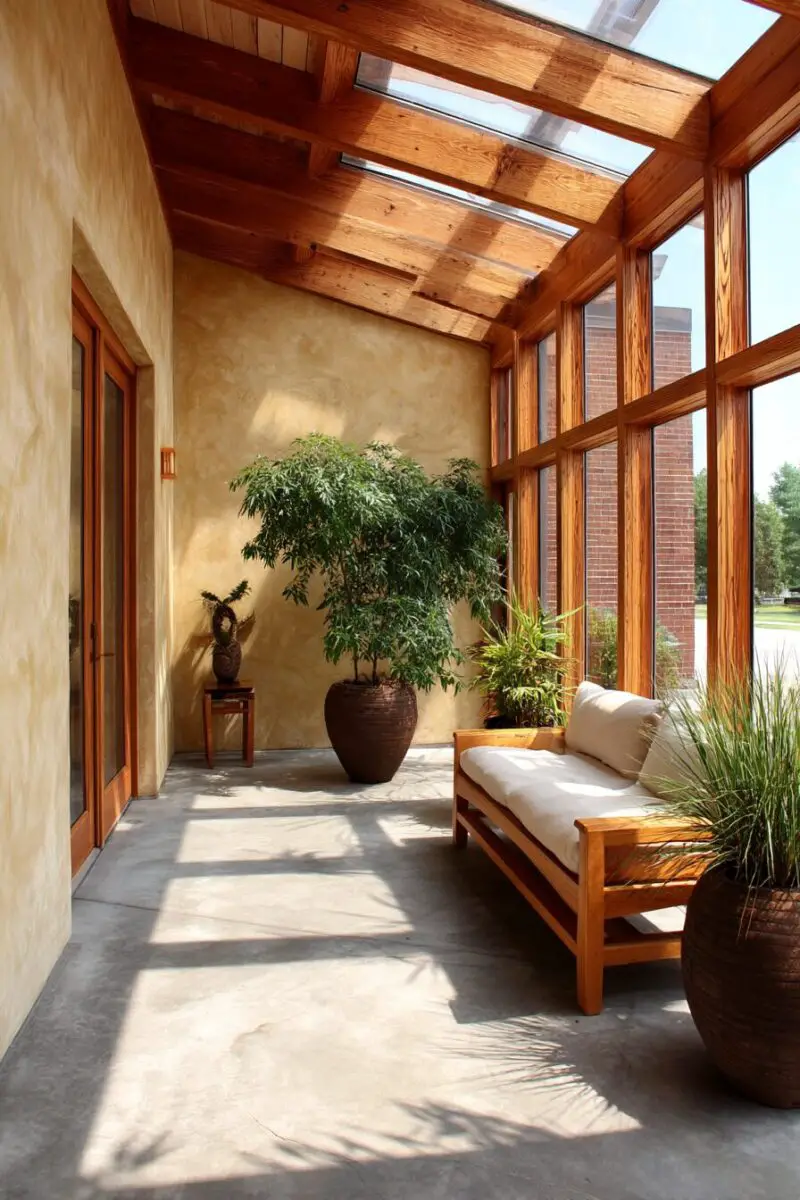

Transform your sunroom into a model of environmental responsibility with designs that minimize energy consumption while maximizing natural comfort.
These forward-thinking spaces begin with careful orientation planning – ideally facing south in northern hemispheres to capitalize on solar gain during winter months.
High-performance glazing serves as the foundation of sustainable sunrooms – triple-pane windows with low-E coatings and proper gas fills dramatically reduce energy transfer.
Thermal mass elements like masonry floors, stone feature walls, or water features absorb heat during sunny periods and release it gradually when temperatures drop.
Incorporate renewable materials throughout the space – sustainably harvested woods, bamboo, cork, or recycled composite materials minimize environmental impact.
Passive ventilation systems reduce dependency on mechanical cooling – operable skylights, ceiling fans, and strategically placed operable windows create natural airflow patterns.
Solar technologies can be integrated beautifully – transparent photovoltaic glass panels, discrete rooftop collectors, or even solar-powered charging stations for devices.
Water conservation features might include rainwater collection systems that irrigate adjacent gardens or supply water features within the sunroom.
Furnishings should reflect environmental values – look for pieces made from reclaimed materials, certified sustainable wood, or innovative recycled textiles.
Living walls or vertical gardens contribute to improved air quality while creating stunning visual impact and emphasizing the connection to nature.
Lighting design prioritizes energy efficiency with LED fixtures, smart controls, and strategic placement that reduces the need for artificial illumination during daylight hours.
Non-toxic finishes, paints, and materials ensure your sustainable sunroom maintains healthy indoor air quality along with environmental benefits.
The most successful eco-sunrooms balance technical performance with beautiful design, proving that sustainability need not compromise aesthetic appeal.
Modern sunrooms offer endless possibilities to connect with nature while enjoying the comforts of indoor living.
Whether you prefer minimalist glass architecture or lush biophilic design, there’s a sunroom concept that can transform your home.
These light-filled spaces create valuable additional living area while potentially increasing your property value.
The key to a successful sunroom lies in thoughtful planning that considers your climate, lifestyle needs, and architectural context.
With the right design approach, your modern sunroom can become the most cherished space in your home—a bright retreat that nurtures wellbeing and brings joy throughout changing seasons.

